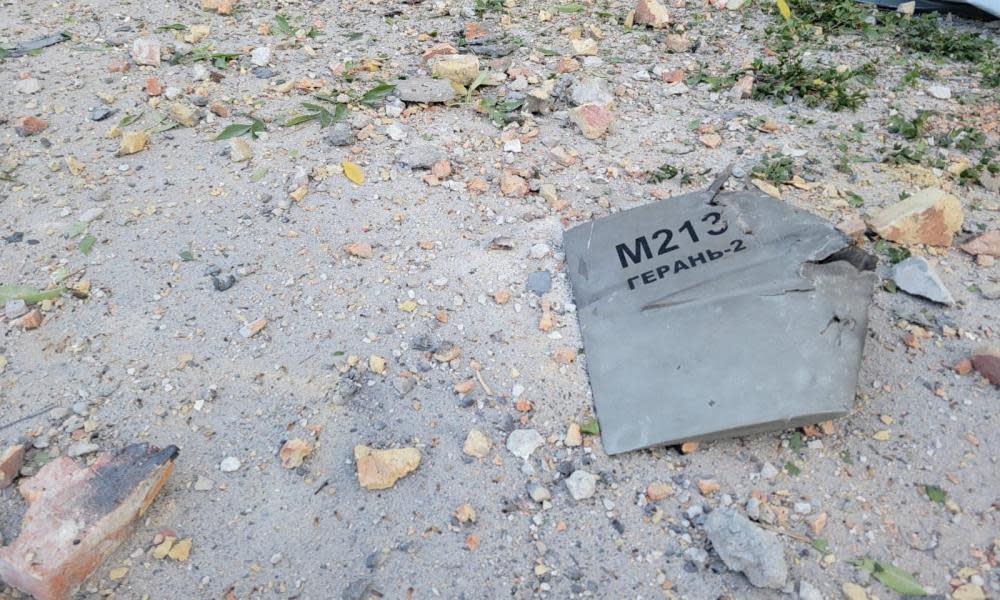Russia escalating use of Iranian ‘kamikaze’ drones in Ukraine

Russia is escalating its use of Iranian-supplied “kamikaze” drones in southern Ukraine, including against the southern port of Odesa and the nearby city of Mykolaiv, amid estimates that hundreds of weapons may now have been deployed by the Kremlin in Crimea and other occupied areas of the south.
The drones – also known as loitering munitions – have also been used against Ukrainian artillery positions in the country’s east, including in the Kharkiv region. Britain’s Ministry of Defence first noted the Russian use of the Iranian supplied weapons in mid-September.
Related: Russia-Ukraine war latest: what we know on day 218 of the invasion
Able to remain airborne for several hours and circle over potential targets, the drones are designed to be flown into enemy troops, armour or buildings, exploding on impact – explaining their description as kamikaze drones.
On Tuesday, Ukrainian armed forces said they had successfully shot down three more Iranian kamikaze drones that attacked Mykolaiv region.
A day before Ukraine’s air force spokesperson Yuriy Ihnat suggested Iran may have supplied “several hundred” of the weapons to Russia.
While drone warfare has become one of the defining features of the conflict in Ukraine, efforts to procure and deploy kamikaze drones have been stepped up by both sides in recent months.
While much attention has focused on Ukraine’s highly successful use of drone warfare – not least that employing Turkish supplied Bayraktar TB2s – Russia has begun relying more heavily on kamikaze drones rather than missiles.
In recent weeks Russian forces have used Iranian-made Shahed-136 unmanned aerial vehicles to hit the Odesa and Dnipro regions with Ukraine’s president, Volodymyr Zelenskiy, citing the supply of the drones to Russia as “a collaboration with evil” behind Ukraine’s recent downgrading of ties with Iran.
Reports suggest that the kamikaze drones used in recent weeks have been launched from Russian-controlled areas including the Crimea and occupied Kherson.
According to Ukrainian military sources some of the drones had been repainted in Russian colours. In one of his nightly addresses at the weekend Zelenskiy accused Iran of supplying the drones, a claim denied by Tehran, which has said it is neutral in the conflict.
“Today the Russian army used Iranian drones for its strikes. The world will know about every instance of collaboration with evil, and it will have corresponding consequences,” Zelenskiy said, a few hours after Oleg Nikolenko, spokesperson for the Ukrainian foreign ministry, tweeted that the Iranian supplied drones had led to the revocation of the Iranian ambassador’s accreditation.
While at least one other kind of Iranian-supplied drone has been identified in Ukraine, the Shahed 136 – also known as the Heran 2 – has been used most frequently, already becoming familiar for its sound like a distant motorbike engine during its approach.
Usually launched in pairs, the 200kg drone – which is armed with a warhead, officially has claimed range of about 2,000km although realistically it is believed to be closer to several hundred with anecdotal evidence suggesting that Ukrainian forces have at times struggled to track the incoming drones.
In a recent interview Oleg Katkov, of Ukraine’s Defense Express, suggested the drones were probably relatively low-tech, assembled from parts that could be bought easily online and guided by a civilian GPS system, with their effectiveness coming from their use in swarms.
“Since this equipment is assembled from low-quality parts, the reliability will be low. That is why the tactics of using these UAVs [unmanned aerial vehicles] involves their use in a so-called swarm. In other words, five to six, or even more, kamikaze drones are launched at one target, assuming that a few of them will fulfil their task.”
Ukraine has also said Russian forces are using another larger and more sophisticated Iranian drone – the Mohajer-6 – which can also be used for reconnaissance flights or armed with munitions, which is also being flown out of Crimea.
Despite Tehran’s denials, there has been mounting evidence of its role in supplying weapons.
The issue was first flagged up in August when Jake Sullivan, the US national security adviser, disclosed that Russian defence officials had been in Iran seeking to purchase drones, with the US earlier this month issuing sanctions against an Iranian airline believed to be involved in moving drones to Russia.
The concern over Russia’s new kamikaze drone tactics – and how to counter them – comes amid reports that Ukraine has also signed a contract for a similar system, the US-made Switchblade 600 although those may not arrive for several months.
With a powerful warhead, which has been compared to the force of a Javelin anti-tank missile, the munition is capable of destroying tanks and other armoured vehicles.
Ukraine has also been seeking intelligence and countermeasures from Israel to use against the Iranian drones. Earlier this month Israel’s deputy director for Euro-Asia, Simona Halperin, visited Kyiv, where one of the issues understood to have been raised was Israeli intelligence on Iranian drone technology.

 Yahoo Movies
Yahoo Movies 
